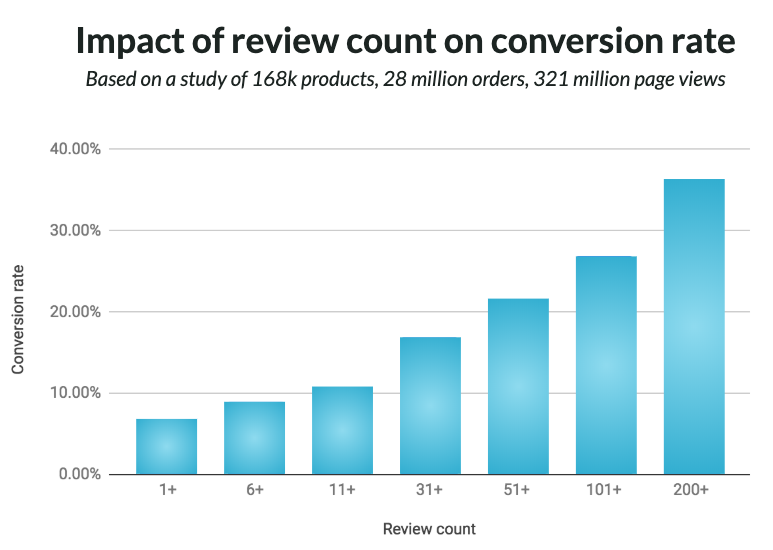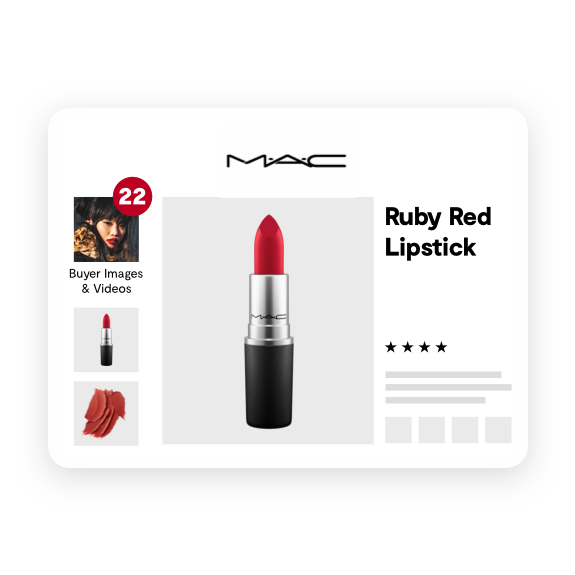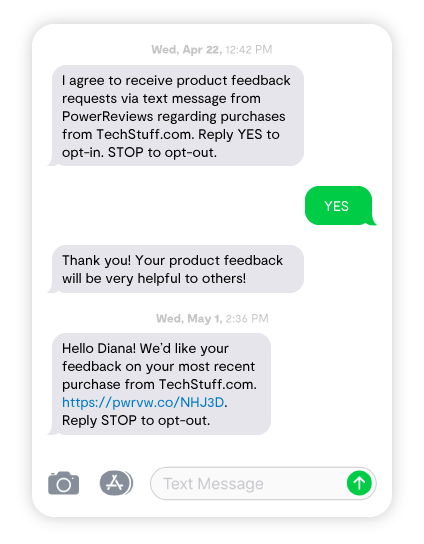Customer opinions hold more weight than ever in the path to purchase and have become an essential brand marketing asset. A recent PowerReviews study found 95% of consumers rely heavily on ratings and reviews before they buy a product online. This now-entrenched shopping behavior creates both challenges and opportunities for brands as they seek stronger connections with their customers.
As customer feedback becomes more influential, one challenge is the growing concern about the authenticity and transparency of ratings and reviews. To protect their reputations, brands must be increasingly vigilant to ensure that the customer feedback about their brands provides a truthful source for product recommendations.
In this blog, we explore how brands can encourage and collect more high-quality customer-generated content, along with three best practices for doing so in a way that increases trust and authenticity.
Collecting more high-quality customer feedback
Consumers expect brands to help inform their purchase decisions by including content with images and videos on product pages and by sharing authentic reviews. Collecting that content is essential to help brands increase conversion. In fact, PowerReviews’ data shows a 25% conversion rate increase on products with reviews compared to those without and, as shown in the following chart, the conversion rate goes up as the number of reviews climbs.

Consumers also look to reviews to answer important product questions, which should also encourage brands to collect more customer feedback and reviews. While one user wants a specific answer to a question, others want an overall evaluation of the product. Further, a recent study shows consumers believe a large number of positive reviews about a brand is a more important indicator of product quality than a trusted brand name.
PowerReviews Director of Insights Carol Krakowski says: “In addition to increased conversion, collecting more, high-quality reviews allows brands to draw key insights across all of their customer feedback, to reach more of their audience with relevance and to activate their community of buyers.”
But brands can’t stop with simply collecting more high-quality reviews: authenticity matters. In fact, 86% of consumers say authenticity is important when deciding what brands they like and support, and 85% of shoppers actually seek out negative reviews prior to purchase. Simply put, brand content is more likely to convert when it’s from a trusted source.
So how can brands collect more content and amp up authenticity? Here are three best practices to collect more customer feedback:
1. Engage everyday influencers through product sampling
More credible and cost effective than celebrity influencers and easier to work with as well, everyday influencers are a community of “people like me.” They use their Instagram presence to generate authentic, meaningful interactions with their followers, who are made up mostly of their friends and family. While these influencers typically have only 1,000 – 5,000 followers, when they make product recommendations, their communities listen.
https://www.instagram.com/p/B76EFqypY9W/
Using innovative sampling campaign techniques, PowerReviews targets the right everyday influencers on behalf of brands, providing them with a product sample or coupon along with encouragement to write a timely, authentic review or to share content about the product on their own social media. As a result, brands see the industry’s highest review submission rates and high social media engagement as well.
A MediaKix study found that in some cases, influencers with just 1,000 followers generate 85% higher engagement than those who have 100,000 followers. And Instagram accounts with greater than 10,000 followers generally have about the same Like:Follower ratio whether they have 11,000 or 11 million followers. By contrast, accounts with 5,000-10,000 followers gain nearly 3% higher engagement, and everyday influencers with 1-5k followers gain 2% higher than that.
“Finding the right audience to engage with can be half the battle. But you can target the exact person you’re looking for with a sampling campaign, and then ask for a review,” Krakowski says, sharing a recent example:
“We work with a vacuum cleaner brand that believes its vacuums are the best in the industry at tackling pet hair. They embarked on a sampling campaign to find pet owners frustrated by other vacuums. We found those very specific everyday influencers within our community and sent them $200 vacuums, asking for reviews. As a result, we helped the brand collect more than 2,000+ consumer-generated images and achieve a 90% product catalog review coverage.”
For brands, targeting everyday influencers via sampling campaigns means spending less, but still generating a higher volume of authentic reviews and engagement. The customer feedback they collect can be shared across ecommerce platforms, partner websites, search and social media platforms and through integrations. And, by encouraging customers to share their experiences on their social channels, product information reaches even further, to their authentic social networks as well.
Finally, the individual customer reviews generated through PowerReviews sampling campaigns are higher quality and on average 29% longer than others because they come from an engaged community of everyday influencers and go through advanced targeting, screening and qualification.
2. Accelerate customer feedback through social collection
Visuals are a critical element of effective customer feedback because actually seeing products in use in the real world adds a layer of trust. The PowerReviews Snapshot for Ecommerce study found 42% of shoppers say it’s important or very important that a product’s reviews include user-submitted photos and videos, and that number jumps to 58% among consumers 18-29.
“Social collection is another important ‘best practice,’ because one of the best ways to improve the authenticity of your content is to encourage reviewers to submit photos or videos,” says Krakowski. “We know that 88% of consumers specifically seek out visuals submitted by other consumers prior to making a purpose. User-submitted photos show products “in the wild”, giving real-life context to user stories. This is particularly important among the younger demographic.”

By implementing a social collection strategy, brands can gather and manage visual content from social channels, brand hashtags and everyday influencers. PowerReviews helps implement this smart solution at scale, so brands can leverage the visuals customers are already posting on Instagram, quickly identifying the right content and requesting permission to share it.
3. Provide easier methods for customers to provide feedback
The third best practice is really all about streamlining the customer feedback process – for both consumers and brands.
Collecting more high-quality reviews requires brands to create an easy path for customers to write or post their feedback. Today, although 95% of consumers use reviews, a much smaller percentage (45%) takes the time to write one. Why? Reasons vary, but often the technology is not accommodating, there’s no incentive or maybe they were simply waiting to be asked.
While it may seem obvious, simply asking for reviews online can encourage customers who are debating whether or not to leave feedback. And by following up with post-purchase emails, brands can collect even more content.
In addition, brands can use advanced collection features to collect more customer feedback data:
- With Progressive Collection, PowerReviews allows the user to flow through reviewing multiple products in a way that’s optimized, showing one product at a time, and having a second question pop up only after they answer the first, etc.
- Visual Content Collection gathers more image and video content from customers by allowing them to easily upload visual content straight from their devices or social media profiles.
- By allowing customers to submit reviews through text, SMS Collection produces higher open rates than email by reaching customers where they spend most of their time!

Krokowski says another good way to collect authentic customer feedback is by adding a Q&A section, making it easy for customers to not only ask questions but also encouraging them to respond to each other’s questions.
“Shoppers often use this section of a page to learn additional information about a product,” she explains, “and having user-generated questions about the product allows you to highlight some use cases or benefits of the product that other shoppers might not have thought of in a completely authentic way because it comes directly from your customers. And, by responding to customer questions you show that you care about engaging with them. Building that rapport with your community is an important part of letting customers know that you’re listening to them, taking their opinions into account. It’s all about building trust.”
It really is all about building trust
By working with a trusted reviews collection partner like PowerReviews, brands have the ability to collect more high-quality, customer-generated content, while following best practices for increasing authenticity and trust through product sampling, enhancing social collection, and creating easier methods for customers to leave feedback. These best practices help ensure that the reviews you collect are high-quality content that your customers will trust.
And, thanks to our open platform, PowerReviews collects more reviews data than any other provider, embracing data from every brand and retailer who wants to share it, regardless of whether they use our software. Our massive data set allows us to offer brands the best insights and deliver the most authentic, personalized experience for billions of shoppers every month.





